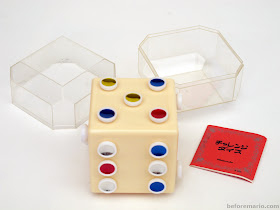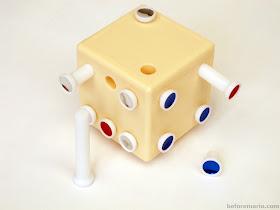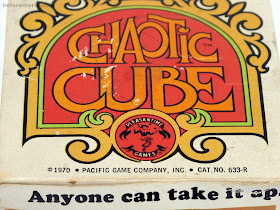In the late 1970s and early 80s, the highly original
Rubik's Cube created a world wide puzzle phenomenon. Nintendo quickly joined the party with the release of the
Ten Billion barrel puzzle in 1980 and (less well-known)
Crossover in 1981.
Many years prior, however, Nintendo already released another puzzle game - called
Challenge Dice. It is a fun puzzle; not too easy, but somewhat less challenging than the name would suggest.
 |
| Nintendo Challenge Dice (1969) |
The
Challenge Dice (チャレンジ ダイス) was released in 1969, and sold for ¥400. Playing cards were still an important part of Nintendo's business at the time, and a puzzle game was a natural extension of their portfolio, as cards and puzzles are often sold at the same places - so existing distribution channels could be used.
The plastic puzzle cube was packaged in a transparent container, and came with a small twelve-page instruction booklet.
 |
| Nintendo patent pending message |
The "one" side of the dice contains an embossed "Nintendo Patent Pending" message.
 |
| Instruction booklet cover |
The instruction booklet contains a Nintendo copyright sign. The inside of the booklet cover contains a sticker with an additional copyright notice: "(c) Sato Tokushu Design". It is not known what their involvement exactly consisted of, but possibly Nintendo's role was limited to production and distribution only, not design.
 |
Inside of instruction booklet,
with additional copyright notice |
The puzzle consists of a traditional dice, with one to six holes on the six sides of the cube.
 |
| Challenge Dice and twenty-one pins to fill the holes |
The holes need to be filled with a total of twenty-one pins in four different lengths. There are two pins of the largest size, eight of the smallest size and four and seven pins, respectively, of the sizes in between. The pins have different colors on their ends, depending on their size.
 |
| The four pin lengths and their number and color |
To start the puzzle, all pins are removed from the
Challenge Dice. The objective of the game is to put the pins back in. The smallest pins go in easily, but the longer pins can block each other on the inside of the dice, so their position needs to be selected carefully, to allow all pins to be inserted completely.
If you want to, you can even disassemble the entire cube (it comes apart in six pieces), and include the assembly as part of the puzzle. It is quite easy to build, but you have to make sure you make the correct sides face each other ("one" opposite "six", "two" opposite "five" and "three" opposite "four"), otherwise it may not be possible to complete the puzzle.
Multiple solutions exist for this puzzle. The instruction booklet provides two solutions, and encourages the puzzler to find more. Space is provided in the booklet to note another 10 solutions, as apparently there are a total of twelve different solutions.
As the smallest pieces always fit (they do not extend into the internal of the dice), the strategy is to focus on the other pins first. When these all fit, the smallest pieces can than be added to the remaining open spots.
 |
| Two of the multiple solutions for Challenge Dice |
Challenge Dice was sold in three different colors: off-white, lime-green and red. The colors of the pins are the same for all three dice color variants.
 |
| All three color variants of Challenge Dice |
In the early 1970s, some years after the initial release of
Challenge Dice, it was repacked under the name
Puzzle Dice and also sold under its original name in the Nintendo
Mini Game Series.
 |
| Nintendo Mini Game version of Challenge Dice (ca 1972) |
Although the name would suggest differently, the
Mini Game version is 100% identical (likely repackaged old stock), except that the cube does not come pre-assembled.
The instruction booklet is also includes, as are (the same) instructions on the back of the blister pack.
 |
| Back of Mini Game blister pack, with instructions |
The
Puzzle Dice version is also identical, except for its plastic bag and the instruction booklet.
 |
| Puzzle Dice |
The
Challenge Dice was also released abroad, under the name
Chaotic Cube. This version surfaced in the US.
The copyright notice on this version reads "(c) 1970 Pacific Game Company", and the brand name is "Pleaseantime Games". It came in a cardboard box.
The slogan on the box states "Anyone can take it apart...that's easy...but to put it together again - Wow; that's a real puzzle!".
When we open the box, that game that comes out is the actual Nintendo
Challenge Dice game, in the transparent plastic container.
The Nintendo patent pending mark is also still present on the dice.
An English language instruction booklet is included.
The booklet states "printed in Japan", which indicates that Nintendo produced the
Chaotic Cube for the Pacific Game Company.
The pictures on the box of the
Chaotic Cube provide a clear step by step guide on how to go about solving this puzzle. These photos are another indication of the involvement of Nintendo in the
Chaotic Cube, as the exact same photos are also used on the front of the blister pack of the
Challenge Dice in the Nintendo
Mini Game Series, pictured above.
Chaotic Cube was released in two different colors: red and green.
 |
| The three different Western releases of Challenge Dice |
Recently a third Western release of
Challenge Dice surfaced, sold under the game's original name. More on this version
can be found here.
Another interesting find was this
Chaotic Cube with outer cardboard box.





































